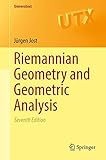Riemannian Geometry and Geometric Analysis [electronic resource] / by Jürgen Jost.
Material type: TextSeries: UniversitextPublisher: Cham : Springer International Publishing : Imprint: Springer, 2017Edition: 7th ed. 2017Description: XIV, 697 p. 19 illus., 4 illus. in color. online resourceContent type:
TextSeries: UniversitextPublisher: Cham : Springer International Publishing : Imprint: Springer, 2017Edition: 7th ed. 2017Description: XIV, 697 p. 19 illus., 4 illus. in color. online resourceContent type: - text
- computer
- online resource
- 9783319618609
- 516.36 23
- QA641-670
1 Riemannian Manifolds -- 2 Lie Groups and Vector Bundles -- 3 The Laplace Operator and Harmonic Differential Forms -- 4 Connections and Curvature -- 5 Geometry of Submanifolds -- 6 Geodesics and Jacobi Fields -- A Short Survey on Curvature and Topology -- 7 Symmetric Spaces and Kähler Manifolds -- 8 Morse Theory and Floer Homology -- 9 Harmonic Maps between Riemannian Manifolds -- 10 Harmonic Maps from Riemann Surfaces -- 11 Variational Problems from Quantum Field Theory -- A Linear Elliptic Partial Differential Equations -- B Fundamental Groups and Covering Spaces -- Bibliography -- Index.
This established reference work continues to provide its readers with a gateway to some of the most interesting developments in contemporary geometry. It offers insight into a wide range of topics, including fundamental concepts of Riemannian geometry, such as geodesics, connections and curvature; the basic models and tools of geometric analysis, such as harmonic functions, forms, mappings, eigenvalues, the Dirac operator and the heat flow method; as well as the most important variational principles of theoretical physics, such as Yang-Mills, Ginzburg-Landau or the nonlinear sigma model of quantum field theory. The present volume connects all these topics in a systematic geometric framework. At the same time, it equips the reader with the working tools of the field and enables her or him to delve into geometric research. The 7th edition has been systematically reorganized and updated. Almost no page has been left unchanged. It also includes new material, for instance on symplectic geometry, as well as the Bishop-Gromov volume growth theorem which elucidates the geometric role of Ricci curvature. From the reviews: “This book provides a very readable introduction to Riemannian geometry and geometric analysis... With the vast development of the mathematical subject of geometric analysis, the present textbook is most welcome.” Mathematical Reviews “For readers familiar with the basics of differential geometry and some acquaintance with modern analysis, the book is reasonably self-contained … The book succeeds very well in laying out the foundations of modern Riemannian geometry and geometric analysis. It introduces a number of key techniques and provides a representative overview of the field.” Monatshefte für Mathematik.
There are no comments on this title.



























